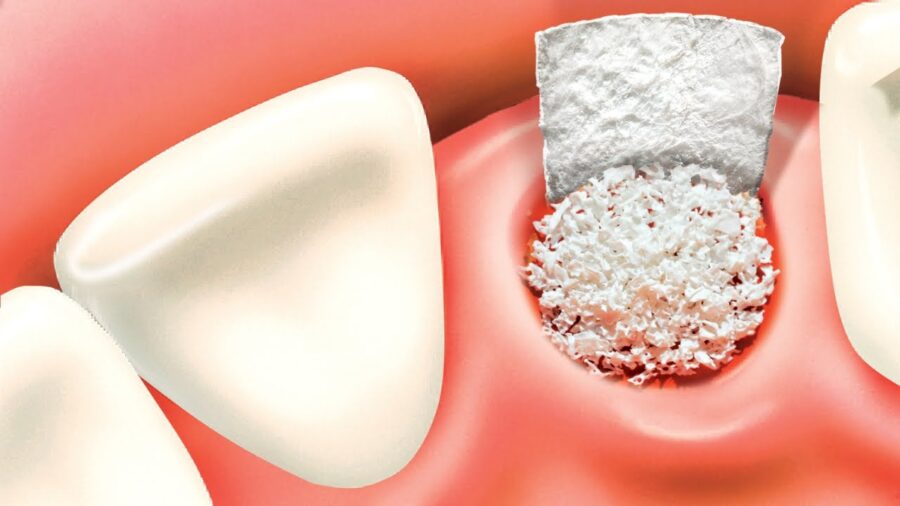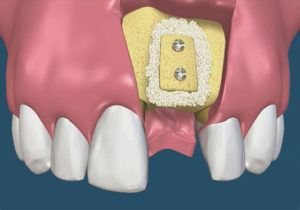Dental implants have revolutionized the field of dentistry, providing patients with a reliable and long-lasting solution for missing teeth. However, not all individuals are ideal candidates for implant surgery due to insufficient bone volume in the jaw. This is where bone grafting in dental implants comes into play, offering a solution to augment and strengthen the jawbone, ultimately enabling the successful placement of dental implants. In this article, we will explore the importance of bone grafting in dental implant procedures, its various techniques, and its pivotal role in restoring smiles
You’ll learn about the different types of grafting, what sort of patients are typical candidates for it, who performs it, and how much it costs if you choose to pursue it as a treatment option.
What is bone grafting?
Bone grafting for dental implants is a surgical procedure that involves transplanting bone tissue from one area of the body to another or using synthetic materials to augment the jawbone’s volume and density. In the context of dental implants, bone grafting serves the purpose of creating a stable and supportive foundation for the implant to fuse with the jawbone.
Bone grafting becomes necessary when a patient lacks adequate natural bone to accommodate dental implants.
There are several reasons why someone might have insufficient jawbone, including:
- Tooth Loss: After tooth extraction or tooth loss, the surrounding bone can gradually resorb, leading to a reduction in bone volume.
- Gum Disease: Periodontal (gum) disease can damage the supporting bone structure, compromising its ability to hold dental implants.
- Trauma: Facial injuries or accidents can result in bone damage or loss in the jaw.
- Resorption: Natural bone resorption can occur over time, especially if teeth have been missing for an extended period.
Bone grafting helps address these issues by adding bone material to the deficient area, thereby creating a more suitable environment for the placement of dental implants.

Bone grafting in dental implants has significantly expanded the range of patients who can benefit from this advanced tooth replacement option. By restoring lost bone tissue, bone grafting not only facilitates implant placement but also contributes to the long-term success and function of dental implants, enabling patients to enjoy a natural-looking and functional smile.
Types of Bone Grafting for Dental Implants
Bone grafting is a crucial component of dental implant procedures, especially when patients have insufficient natural bone to support the implants. Various types of bone grafting techniques are used to augment the jawbone’s volume and density, creating a suitable foundation for successful dental implant placement. Here are the primary types of bone grafting for dental implants:

- Socket preservation. Sometimes called ridge preservation, this type of graft is placed in the socket immediately after tooth extraction. It fills the void left behind by the missing tooth and prevents the sides of the socket from caving in.
- Ridge augmentation. If your teeth have been missing for a while, the supporting jawbone may be thinner than it was before. Ridge augmentation increases the width and volume of the jawbone so it can provide a stable foundation for implants or other restorative options.
What is Sinus Lift Surgery in a Bone Grafting Procedure?
A sinus lift surgery, often referred to as sinus augmentation, is a specialized bone grafting procedure performed in dentistry to increase the amount of bone in the upper jaw, particularly in the posterior region. This surgical technique is typically required when there isn’t enough bone height in the upper jaw to support the secure placement of dental implants.
The upper jawbone, or maxilla, contains air-filled cavities known as the maxillary sinuses. These sinuses are situated above the upper molars and premolars. In cases where tooth loss has led to bone resorption or the natural bone in this area is too thin, a sinus lift surgery is performed to create additional space and provide adequate bone support for dental implant placement.
How Does a Dental Bone Graft For Tooth Implant Work?
A dental bone graft is a surgical procedure that dentists often recommend to patients who require dental implants but have insufficient bone in their jaw to support the implant. Here’s a step-by-step explanation of how a dental bone graft works:

- Evaluation and Diagnosis: Before the bone graft procedure, the oral surgeon or dentist assesses the patient’s oral health through a thorough examination, which often includes X-rays or CT scans. This evaluation helps determine if there’s insufficient bone in the jaw to support dental implants.
- Graft Material Selection: Based on the patient’s specific needs and the severity of bone loss, the healthcare provider selects an appropriate grafting material. There are several options, including the patient’s own bone (autograft), donor bone from another human source (allograft), bone from animals (xenograft), or synthetic materials (alloplasts). The choice depends on factors like patient preference, availability, and clinical suitability.
- Surgical Procedure: The bone grafting procedure is typically performed under local anesthesia, ensuring the patient’s comfort. During the surgery:
- If an autograft is used, bone tissue is harvested from another part of the patient’s body, such as the hip, chin, or jaw.
- If an allograft or xenograft is used, the prepared graft material is placed into the deficient area of the jawbone.
- If an alloplast is used, synthetic graft material is positioned in the targeted area.
- Graft Integration and Healing: Following the graft placement, the patient is given time to heal. During this healing period, the body gradually replaces the graft material with new bone tissue through a process known as osseointegration. The length of the healing period can vary but often spans several months.
- Dental Implant Placement: Once the graft has integrated with the natural bone and achieved sufficient density and stability, the dental implant can be surgically placed into the augmented site. This implant serves as an artificial tooth root.
- Osseointegration: After dental implant placement, the process of osseointegration continues. The implant gradually bonds with the surrounding bone, ensuring its long-term stability and anchorage.
- Restoration: Once osseointegration is complete, the patient’s dentist can attach the desired dental restoration, such as a crown, bridge, or denture, to the dental implant. This restoration resembles a natural tooth and provides the patient with a functional and aesthetically pleasing solution for missing teeth.
So are you ready for a successful Smile Makeover in Mumbai? Let’s Chat! Get in touch with Royal Dental Clinic for a Bone Grafting Consultation. We’re here to help you achieve a confident and beautiful smile. Contact us today – your journey to better dental implants starts now!
Who Needs a Dental Bone Graft?
A dental bone graft may be needed for individuals who:
- Have Insufficient Bone: Those with insufficient jawbone due to factors like tooth loss, gum disease, trauma, or natural bone resorption may require a bone graft to ensure there’s enough bone to support dental implants.
- Plan for Dental Implants: Patients considering dental implants but lacking adequate bone in the implant site often require bone grafts to provide a stable foundation for the implants.
- Desire Aesthetics: Bone grafts can also be utilized to enhance the aesthetics of the smile. This is especially important when missing teeth have led to unattractive gaps or contours in the gumline.
- Seek Functional Restoration: Individuals who want to regain the ability to chew, speak, and smile comfortably without the risk of implant failure due to insufficient bone will benefit from bone grafting.
In essence, dental bone grafts are suitable for those seeking dental implants or improved oral aesthetics and functionality, especially when natural bone is lacking in the jaw. Consulting with a dentist or oral surgeon can determine if a bone graft is necessary for your specific case.
How much does a bone grafting procedure cost?
The cost of a bone grafting procedure in India can vary depending on a number of factors, including the type of graft material used, the extent of the procedure, and the geographical location of the dental clinic.
Synthetic bone grafts are typically less expensive than autografts, which use bone from the patient’s own body. A simple bone graft may cost less than a more complex procedure that requires more bone material or a longer surgery time. The geographical location of the dental clinic can also affect the cost of the procedure, as the cost of medical care can vary from country to country and even from city to city.
In addition to the cost of the bone graft itself, there may be other costs associated with the procedure, such as anesthesia, imaging tests, and medications. It is important to discuss the cost of bone grafting with your dentist or oral surgeon before the procedure so that you are aware of all of the potential costs involved.
Conclusion
Bone grafting is a vital component of successful dental implant procedures, allowing patients with insufficient bone volume to enjoy the benefits of a complete and functional smile. With advancements in dental technology and various grafting techniques available, more individuals can now experience the life-changing benefits of dental implants. If you are considering dental implants but have concerns about bone volume, consult with our experienced dentist to explore bone grafting as a viable solution for your dental restoration needs.






